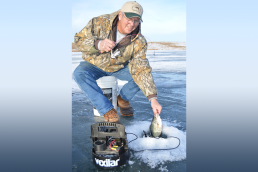‘Fish Finders’ on Ice
SHARE THIS POST
Used for ice fishing, sonar units really are fish finders.
Recently, a fishing friend and I were talking about ice fishing. My friend wanted to get more involved in ice-fishing. We talked about the equipment that he should consider purchasing. Our conversation soon turned to sonar, a.k.a. “depth finders,” a.k.a. “fish finders,” and whether he needed one. My friend understood the value of sonar in open water but wasn’t so sure it was needed when ice fishing.
I told my friend that he could use my sonar next time he went ice fishing. He took me up on that offer. When he returned it after a few hours on the ice, he declared, “I need to get a fish finder like yours!” He discovered what most people who fish through the ice know: Sonar will help you catch more fish. Here’s why.
When ice fishing, sonar is used primarily to determine if fish are present. A depth finder adjusted properly—and it’s easy to adjust them properly—will show the tiniest of jigs. They will show if a fish is below your hole in the ice. And they’ll help you decide what type of bait the fish are interested in.
The most successful ice anglers drill a good number of holes in an area and then move from hole to hole, searching for fish. They put the sonar’s transducer in the hole, lower a bait, and watch for a fish to approach it. If no fish life is detected in a few minutes, they move to another hole. They keep moving until they find fish. When they find a hole with fish underneath, they spend some time there. This is when the “fish finder” takes on a new role.
Once fish are located, use the sonar to position your bait. When a group of fish is found, some will usually be more aggressive. Let’s say we’re fishing for perch. Our sonar reveals some that are very close to the bottom. Lower your bait until it’s two or three feet above them. See if they’ll come up to it. If they do, they’re often going to bite. If they don’t, lower it so it’s a little closer to them. Make the aggressive fish come up to the bait. They’ll usually move farther in clear water and you’ll need to get it closer to them in stained water.
Are you enjoying this post?
You can be among the first to get the latest info on where to go, what to use and how to use it!
This brings us to another function of sonar. We find some fish and they come up to look at the bait, but they don’t eat it. They’re interested, but they’re playing hard-to-get. When they look but don’t eat, you need to convince them to eat. Try a different lure color or size. Maybe move the bait slower or faster. Try different presentations until you find what they want. If they don’t respond to anything you show them, find a different hole, but remember to come back to that one. At some point during the day, they’re going to be hungry. You want to be there when they are.
Vexilar sonar units are very popular among ice anglers. They’re reliable, easy to use, and available in several models. One of them will be just right for any ice angler.
If you want to be more successful in your ice fishing, using a fish finder and paying attention to what it’s telling you will help you put more fish on the right side of the ice.
Get better results from the time you spend fishing. Use information from the pros found in every issue of MidWest Outdoors, available by subscribing on our website.
MWO
SHARE THIS POST
You may also like...
Nothing found.
Did you enjoy this post?
You can be among the first to get the latest info on where to go, what to use and how to use it!
Bob Jensen
To see the latest episodes of “Fishing the Midwest” television, new fishing-related tips and articles from the past, visit fishingthemidwest.com. Follow them on Facebook @fishingthemidwest for fishing information and entertainment.
